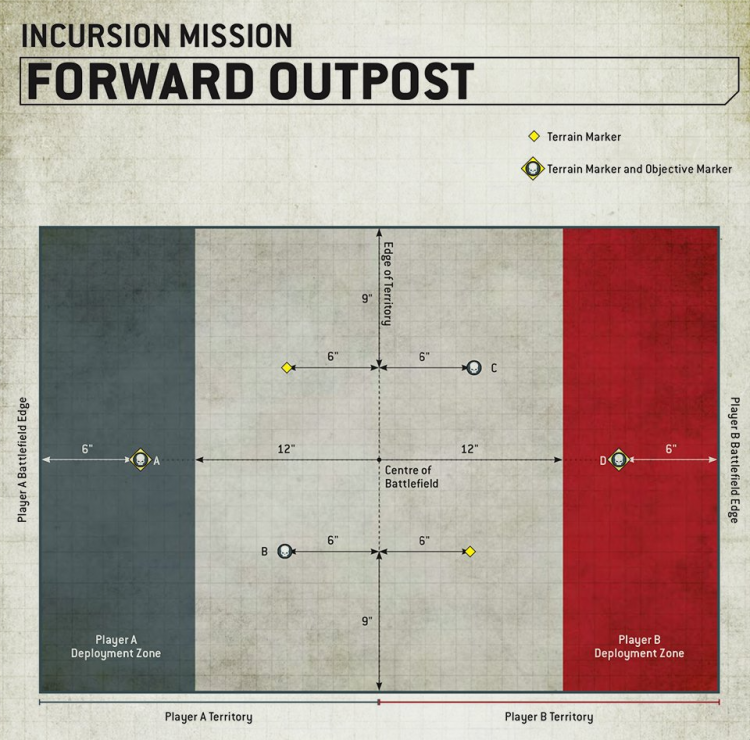One of the more interesting announcements to come out of last month’s streaming preview, the Tactical Deployment promised a new way to play that would have players bringing their own terrain to battles and building battlefields to suit their armies. Given that balanced games in 9th edition seem to require a bit more terrain than 8th edition, this was an intriguing prospect. Heightening the intrigue was the notion that Tactical Deployment wouldn’t be a Narrative Play supplement, but would instead focus on adding a new dimension to Matched Play.
Without much more information to go on, we were left to speculate on how exactly all this would work, but now the wait is over – thanks to Games Workshop, we have a preview copy of Tactical Deployment in hand and in today’s review we’re going to talk about the book’s contents in detail.
What’s In The Book
Let’s start with the contents, because there are a few interesting decisions here. This spiral-bound book, which has the same basic feel and layout as the 2020 GT Mission Pack, is split into two sections: Rules for the new Tactical Deployment mission pack and a copy of the game’s core rules. Yes, in similar fashion to the GT mission pack, this book also has reprinted core rules for Warhammer 40k 9th edition, ensuring you’ll only need one book when you go play. The goal here seems to be that whichever mission pack you’re playing, that’s the only book you need to pick up outside your own codexes. That’s pretty cool, especially given the lightweight form-factor, but it can also mean that if rules change you’re more likely to have multiple incorrect books (right now, between the core rulebook, the GT pack, this book, and the new Beyond the Veil narrative pack which we are also reviewing today, there are 4 extant versions of the core rules and none of them is up to date with the new FAQs since they would have been printed before they came out). The Tactical Deployment rules, which are the actual new content on offer here, include 18 missions – 3 Combat Patrol / 6 Incursion / 6 Strike Force / 3 Onslaught – plus a new game setup sequence and some extra secondaries.
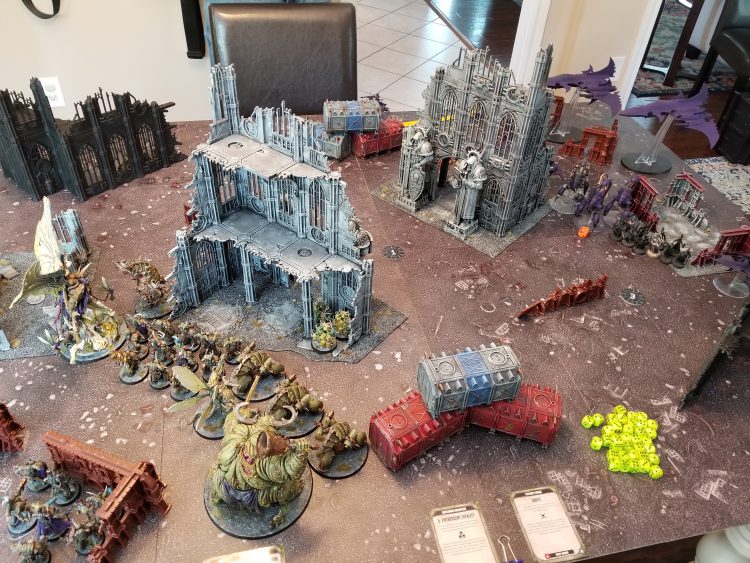
What is a Mission Pack?
This is something we feel is worth clearing up ahead of the main body of the review, since we’ve seen a lot of speculation online as to how exactly these rules relate to the existing missions, and whether these are some sort of “add-on” for existing competitive missions such as the GT2020 pack.
The answer to that is “no” – a mission pack is a standalone, complete set of rules for playing a set of missions, separate to any others. You use this pack to play “Tactical Deployment Games”, which have their own set of numbered steps for setting up and playing a mission, and their own set of missions for each game size. The rules presented here are clearly a spin-off from the GT 2020 pack, but all the content that they need from that pack is reproduced here, and this book gives you a complete way to play in its own right.
Basically, this book provides you with the complete rules for playing the Tactical Deployment missions – it doesn’t say “here are some extra rules that we recommend you add to your GT2020 games and tournaments”. No-one is forcing you to use them unless you choose to and major tournaments aren’t going to be requiring you bring your own terrain box to the event.
Okay?
Everyone gonna put down their pitchforks now?
Let’s get into how this all works then.
Playing Tactical Deployment
So here’s how it works: Before the game players are given a number of Terrain Points to work with. These are basically like the points you’d build an army with – each terrain datasheet has its own rules and a points value. The number of points each player has available depends on the size of the game; you get a maximum of 100 for Combat Patrol, 150 for Incursion, 200 for Strike Force, and 400 for Onslaught. All of your terrain has to have the same Battlezone keyword (i.e. SECTOR MANUFACTORUM) or the “ALL BATTLEZONES” keyword and you have limits on the number of repeat datasheets you can have based on the game’s points value, making it a bit like army construction. Unlike army construction, however, you also have a minimum required number of terrain features, preventing you from just showing up with nothing and forcing a game on planet bowling ball.
After Deployment Zones are chosen, players place this terrain on the battlefield. Tactical Deployment missions split the table up into two player territories, which essentially gives each player half of the table to work with. Players then alternate placing terrain in their territory, starting with the player who lost the roll-off for choosing deployment zone. Players have to start with the terrain features that have the highest points values first, and work in descending order from there, which means that the largest and most important buildings will typically be deployed first.
Terrain can’t be placed within 3″ of a battlefield edge or another terrain feature (though there are exceptions to this), but in a break from the GT2020 rules you explictly can place area terrain or a hill where an objective marker is, and when you do it gets moved to sit on top of the terrain. Additionally, every deployment map has terrain markers on it, which mark where terrain features have to be placed during this step – you have to place pieces of terrain wholly within 9″ of these markers before you can place terrain features anywhere else. Combined with the fact that you have to place your most expensive (so presumably largest) pieces of terrain first, and these effectively become the places on the board that the most significant terrain pieces up. This seems very sensible, as it limits how ridiculous a board you can end up with, and also let the designers make some missions be explicitly about fighting for an objective that’s within terrain by putting an objective and terrain marker in the same place.
Finally, a rule is added (used in some secondaries) that defines what it means to “control” a terrain piece. Obstacles are controlled in the same fashion as an objective (other than being bigger and a different shape, obviously), while Area Terrain is controlled by whichever person has the most models with Objective Secured wholly on or within it, or if neither player has anything with ObSec it falls back to a straight model count. Actually doing a differential count of ObSec models is slightly different to the normal Objective rules, so do bear this in mind while playing games. Rob’s Note: This is basically how lots of players think ObSec works, and they’re shocked to find out it doesn’t, so I don’t love that there’s a more legitimate reason for their confusion now.
Once players have finished placing terrain, they progress to choosing Secondary Objectives and getting on with the game as normal.
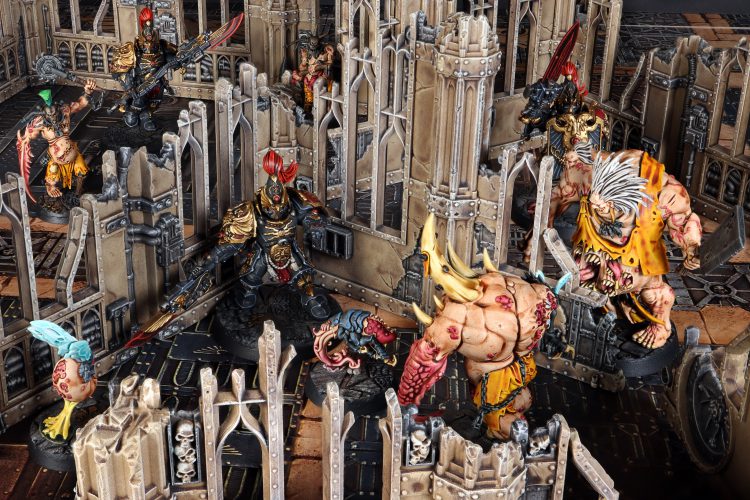
Credit: Pendulin
The Missions
You all love lists, so here’s our quick bullet-pointed take on the pack:
- The missions are actually surprisingly good!
- Terrain markers should be on the regular GT maps, especially for events with player-placed terrain
- The additional Secondaries are mostly OK
- The Mission Secondaries are, on the whole, pretty great – they’re a nice mixture of well-balanced competitive secondaries and a small scattering of fun, thematic ones.
- Holding Critical Feature terrain is a great thematic rule
One of the biggest things about these missions is that their deployment maps – which we’ve seen previewed already – all contain Terrain markers that dictate where terrain has to be placed before players can place other features. These are actually a great idea and something that we’d like to see in the GT missions pack, since since they can help direct players and TOs to ensure appropriate terrain layouts for missions without dictating the exact terrain features that have to be used or the layout for the entire table. Otherwise, they’re structurally similar to GT missions, which makes sense as they’re intended to be for matched and competitive play.
The New Secondary Objectives
In addition to the new terrain rules, Tactical Deployment missions also feature a new set of secondaries, one for each category as follows:
- Battlefield Supremacy – Outright Domination, score 3 VPs at the end of the game for each CRITICAL FEATURE terrain feature you control
- No Mercy, No Respite – Targeted Destruction, score 4 VPs at the end of the battle round for each enemy unit that was destroyed in that battle round while within 3″ of a CRITICAL FEATURE terrain feature
- Purge the Enemy – Stronghold Denial, score 5 VPs at the end of the battle for each enemy BUILDING unit that is destroyed
- Shadow Operations – Plant Demolition Charges, score 4 VPs at the end of the battle for each terrain feature in your opponent’s territory that has explosives planted on it. Planting explosives is an action that one INFANTRY unit can perform if it is wholly in enemy territory and within 1″ of an Obstacle or Area Terrain feature that doesn’t already have explosives on it, started in the Movement phase and completed at the end of your next Command phase.
- Warpcraft – Psychic Imprint, score 2 VPs at the end of the battle round for completing a WC4 psychic action, which allows you psychically scan any terrain feature in your opponent’s territory which has not already been psychically scanned
These are a mixed bag. Outright Domination is cool, and a genuine option for end-game scoring is nice to see (and a similar version for end-game objective holding would have been very appreciated in the GT pack). Targeted Destruction continues the CRITICAL FEATURE theme. It’s a bit of a gamble in that your opponent can deny your scoring by simply not being within 3″ of such terrain, but the obvious trade-off is that they then don’t get to use any of those terrain features. Both of these are sometimes-foods depending on game plan and match-up but I can see reasons to take both of them. Rob’s Note: Also, we have NO IDEA what CRITICAL FEATURES look like because they haven’t been shown on any of the previewed datasheets.
Plant Demolition Charges is probably the pick of the bunch – a good crop of VPs per action, presumably a wide variety of targets on offer, and a good alternative to Raise the Banners High. With half of the board to play with it shouldn’t be too hard to find four terrain pieces to throw explosives onto, and even if you’re not able to max it even getting 2 or 3 is a good crop of points.
Stronghold Denial on the other hand is awful. With no datasheets to hand apart from the single one published on Warhammer Community we don’t know exactly what terrain features there are that may or may not have the BUILDING keyword but the very likely answer is ‘none or almost none of them’ and at that point you’re…. back to hoping your opponent brings three fortifications? Someone at GW has an absolute fascination with buildings being a thing (ask any Imperial Fists player) and keeps writing rules that work against them but hasn’t yet come up with any compelling reason that they would actually be on the table in the first place. The theory seems to be that if you BUILDING it, they will come.
Psychic Imprint is also on the weaker end of the spectrum, being basically a harder to achieve Plant Demolition Charges that awards fewer VPs, with the slight trade-off that you can scan some barrels or something instead of being restricted to merely the two most common types of terrain. You can fail to cast it, it’s max 10 points, you still have to be pretty much as close as you do for demo charges, and it can be achieved by far fewer units. Psychic actions consistently seem to be pitched way too weak and this is just one more in the trend.
The Mission Pack
Similarly to the main rulebook mission pack, there’s missions for each game size in here – 3 each for Combat Patrol and Onslaught (i.e. the smallest and largest sizes), and then 6 for Incursion and 6 for Strike Force. We’re going to look mainly at the Incursion and Strike Force levels here.
In order from the book, the missions are as follows:
Incursion
- Meeting Engagement – Dawn of War deployment – 4 objectives – Take and Hold primary (1/2/more)
- Forward Outpost – Hammer and Anvil deployment – 4 objectives – Take and Hold primary (1/2/more)
- Base of Operations – Hammer and Anvil deployment – 4 objectives – Take and Hold primary (1/2/more)
- Firesweep – corners deployment (the deployment zones touch in the centre) – 4 objectives – Take and Hold primary (1/2/more)
- Denied Front – Dawn of War deployment – 3 objectives – Take and Hold primary (1/2/more)
- Encircling Manoeuvre – Search and Destroy deployment – 4 objectives – Take and Hold primary (1/2/more)
Strike Force
- Protect the Nerve Centre – Vanguard Strike deployment – 5 objectives – Take and Hold primary (1/2/more)
- Drawn Battle Lines – Dawn of War deployment – 6 objectives – Domination primary (2/3/more)
- Take the High Ground – Dawn of War deployment – 5 objectives – Take and Hold primary (1/2/more)
- Aggressive Strike – Hammer and Anvil deployment – 5 objectives – Take and Hold primary (1/2/more)
- Protected Assets – Hammer and Anvil deployment – 4 objectives – Take and Hold primary (1/2/more)
- Deny the Foe – Search and Destroy deployment – 4 objectives- Take and Hold primary (1/2/more)
There’s no difference on the primary scoring to the other packs, and indeed only one Domination mission with all the rest being Take and Hold. Some players might find that welcome, frankly. As mentioned earlier, in several missions you place terrain and objectives together – a bit of a reversal from the GT pack, which explicitly tells you not to place objectives in terrain. This should give the missions heavily themed around this, such as Protected Assets, a distinctly different feel, especially for INFANTRY heavy armies.
There’s a genuinely good set of mission secondaries associated with these. A large number of these are scored at the end of the battle round, and look quite generous to the player going second but quite tricky if you pick them then end up going first. This is a great balancing mechanic, and something we wish there was more of in the main missions.
Our pick of the bunch includes the following:
- Hard Push from Aggressive Strike – Each objective is labelled A to E – you can do an action on each one with any unit and score a number of points depending on which objective it is, with objective A being worth 1 point to player A or 9 points to player B, objective B being worth 2 or 5, player C being worth 3 to either player, and so on. There’s a ton of ways to attack this, either trying to hold the mid-board and pick up a slow stream of points or going in hard to get a big 9pt turn from taking your opponent’s point, and being able to do it with any unit makes it very flexible. Forward Push from Forward Outpost in the Incursion pack works similarly, but obviously on a smaller scale.
- Deny the Foe from, uh, Deny The Foe – Score 2VP at the end of the battle round if you control both objectives in your territory, and/or 3VP if you control one of the ones in your opponent’s territory. This one in particular we would just slam straight into the GT mission pack if it were up to us, as it provides a real angle for the player going second to play a defensive game for a few turns then sweep out to claim victory later in the game, and having a few missions where this plan is viable feels like a healthy safety valve.
- Encirclement from Encircling Manoeuvre – Score 5VP at the end of the battle round if you control the two objective markers in the centre of the two ‘neutral’ quarters
Possibly in the ‘not good but quite funny’ category is The High Ground, which scores you 4VP for holding the tallest objective in both your and your opponent’s territory.
Some of the others are similar to ones we’ve seen before, but in general they’re just consistently better choices than the GT pack – there’s no garbage like Minimise Casualties in here.
The other really nice thing is that, with positioning being a bigger deal, the non-Strike Force maps in this pack are correctly scaled, so you get a nice, precise layout that gives you a clear idea of how things are going to go down.
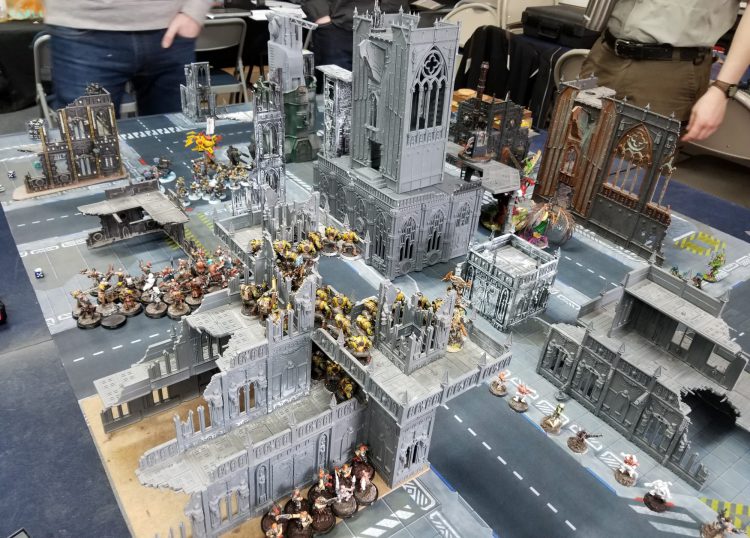
The Terrain
So – we have some decent basic rules and some good-looking missions. All in all, this is looking much more promising than many anticipated. Last thing we need is some terrain pieces to go on our Tactical Terrain Rosters.
Unfortunately and unexpectedly, this is where the release goes off the rails.
On the back of the book there’s a note saying “In order to use this mission pack you will also need the contents of at least one Battlezone set”, and they mean it – to our surprise there aren’t any “generic” datasheets for common categories of terrain feature like hills and corner ruins. There is only a single example of a datasheet within the book itself, and based on that and what’s been previewed on Warhammer Community, as far as we can tell:
- Datasheets are only going to exist for official GW kits.
- These datasheets are going to require you to build the terrain in the recommended configuration.
The terrain datasheet pack only covers the Sector Manufactorum and while it’s possible cards or PDFs will be released for older sets, you currently need to own a really quite specific sub-category of terrain to be able to use these rules at all. Right now what we can say for certain is that the Vertigus terrain will be covered under the Sector Manufactorum alongside the Sanctum Administratus and Sub-Cloister and Storage Fane, and the soon-to-be-repackaged Munitorum Crates and Conservators, but whether we’ll see datasheets for Sector Mechanicus terrain or Sector Imperialis or the Deathworld forest is anyone’s guess.
That’s a tough sell. Genuinely, having gone through this book we were quite excited to try some games of it, but tying it into not just GW-only stuff, but a specific and (mostly) new subset within that makes the barriers to doing so quite large, and it means the product will live and die on enough people being willing to go that extra mile and buy a set of terrain kits just to go with it. If the rules do prove popular then people will probably come up with fan-made datasheets covering some standard-ish sized pieces, and there still could be some of those in the upcoming card pack, but if you want to do this properly you’re probably quite restricted in the terrain you can use. In addition, as of yet we don’t exactly know what a “critical feature” looks like, so some of the rules still have a question mark over them.
That rolls onto the next problem – for Strike Force games in particular, it feels like you’re going to end up with tables that are very sparse. The one previewed card we’ve seen costs 40 of your 200pts for a relatively small ruin that doesn’t have the Obscuring keyword, and the one previewed in the Tactical Deployment rulebook also lacks obscuring for a 60-point structure. Strong evidence suggests that 9th works best with a fairly heavy amount of Obscuring terrain on the table, and you’re simply not going to have that at these prices. Things feel much better at Incursion size, both because worries about getting alpha striked are a bit less severe and because you only have 50 fewer points to spend on terrain each, despite the table being literally half the size. Bizarrely, things get fixed again at Onslaught size, where the point limit doubles from Strike Force, even though the board is only 50% larger.
It really feels, here, like either the Strike Force limit is wrong or has been pulled down to make sure that the contents of a Battlezone box are enough to technically meet it. If that’s the plan, though, it just isn’t going to work – on reading through the set-up rules we very much expected to find a step after the ‘players place their purchased terrain’ bit which said ‘and now add generic terrain’ or something similar; said step simply doesn’t exist, and therefore means that only the stuff you bought comes to the table. Even if both players buy their maximum 200pts it’ll be thin, but if one player swings for the minimum, there will be very little by way of terrain features on the table at all, which is bizarre for a release which is meant to be all about terrain.
Finally, terrain pieces have special rules – again we need to see the full set to properly judge how much complexity this adds, but if every terrain piece has unique rules (as all the ones we’ve seen thus far do) then the amount of book keeping in larger games is going to get considerable, and often be forgotten. Having the physical cards will probably help, as we guess you can just throw them onto the table next to the relevant piece as a reminder, but whether it will add enough interest to be worth the extra mental load remains a question mark.
Rob’s Note: I feel like this is also the kiss of death for casual play for this product as well – by forcing players to buy specific terrain and build it to spec, you’re immediately alienating casual players who already have terrain they enjoy or sweet custom things that they’ve built. I think when most players on the casual end pictured this in their heads, they pictured building their own terrain and building a table with it, not buying a bunch of the new kits and building them exactly how the instructions specify. And while we’re on this note, there’s also the odd decision to dictate area terrain footprints without having them. To which I want to take the opportunity to say: Games Workshop. I’m begging you. Please make plastic terrain bases. You can literally just re-release the large tiled plastic plates you put out for Warhammer Fantasy basing kits. Those are amazing.
Taking everything together, it really looks like Incursion sized games are the sweet spot for this. You end up with enough terrain on the table, you don’t have too many new special rules to deal with, and getting enough kits to fill out your roster doesn’t look unreasonable. At any other size, we’ll need to see the cards to make a final call, but it’s fair to say we’re skeptical.
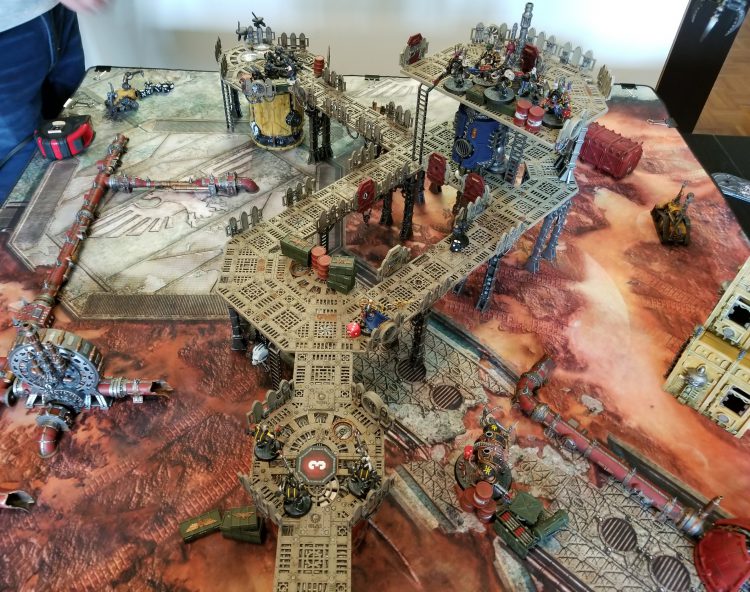
Tournament Play
So, the million dollar question – GW have been fairly heavily pushing the idea that this pack could be used for tournament play, so do we think that’s likely to actually happen?
On the positive side, the rules here look pretty balanced – care has clearly been put into designing the missions and rules so that players can’t abuse terrain placement too badly, and instead it becomes another angle for strategy and tactics. In addition, TOs being able to run a small event without having to provide terrain for every table genuinely does break down a lot of barriers to entry, so this could provide a useful way to kickstart events in a new community.
Unfortunately, we feel that theory falls down in part because of the rules being tied to new GW kits. Removing the requirement for TOs to provide X tables of terrain helps – but restricting the potential participants in an event to only those who are willing to buy and bring along new GW terrain kits immediately cuts the potential market for such events down to size. There’s a real catch 22 here as well – events like this can only run if people want to play in them, but a substantial subset of the player base are only going to buy the terrain kits if they are confident that events are going to run. Realistically, it feels like rather than removing the barrier for events kicking off in a community it just kind of shifts it. Spreading it out around lots of participants makes the cost to each individual lower, but it also increases the number of people you have to persuade to make a purchasing decision before it can happen.
That does feel something that’s fixable. If the cards land and they have a few more “generic” options (e.g. “ruin no larger than X” by Y””) or GW decide to push out some PDFs providing rules for their older families of kits like Sector Mechanicus or Sector Imperialis, there probably is scope for Incursion-sized events of this to kick off. Stores only needing to provide the space for players to set up two of the 30″x22″ mats combined with players needing to bring 3-5 pieces of terrain each (manageable alongside a 1K army) feels like it could be a viable model. Even that does still have significant barriers to it working, however, and we think such events will be rare and unlikely to grow to Strike Force sizes.
As it is, if you were a TO or competitive player worrying about mass adoption of these rules, you can go ahead and release your pearls.
Final Verdict
Tactical Deployment is an odd book to judge. There are some really great ideas here, such as the terrain markers on deployment maps, themed additional secondaries, and great mission secondaries that should really get a look in next year’s Grand Tournament Missions Pack. In addition, some of the ideas here feel like they’d be great building blocks for later content – it feels like there’s some stuff here that would build very well into a future Cities of Death themed pack for either Crusade or Competitive play.
On the other hand, the execution of the core terrain-buying conceit – the lynchpin idea of the whole book – is just kind of awful and lets the whole thing down. It feels a lot like there was a set of rules to make up a proposed extra mission pack which was only tied in to the model release quite late on; this feeling is not helped by the page which strongly implies there will be terrain datasheets in the book which are simply not there. If feels like only working with the Battlezone terrain was a last-minute change, and the final version of the book retains a tantalising suggestion that at some point some more generic options might have been available.
Because of that, the best we can say is that if you really love the gimmick or if your group is happy to try out some good new missions and adapt them to slightly more normal play, then it’s worth a look. It’s also a nice way to add some variety if you play regular Incursion-sized games with either a family member or a small circle of friends and can pool on picking up some Battlezones. On the other hand, if your main interest is buying things which are going to make a permanent impact on organised play, then you can probably afford to give it a miss.
If you have any comments, questions or suggestions, give us a shout at contact@goonhammer.com, otherwise stay tuned for our Beyond the Veil review, coming (very) shortly.

